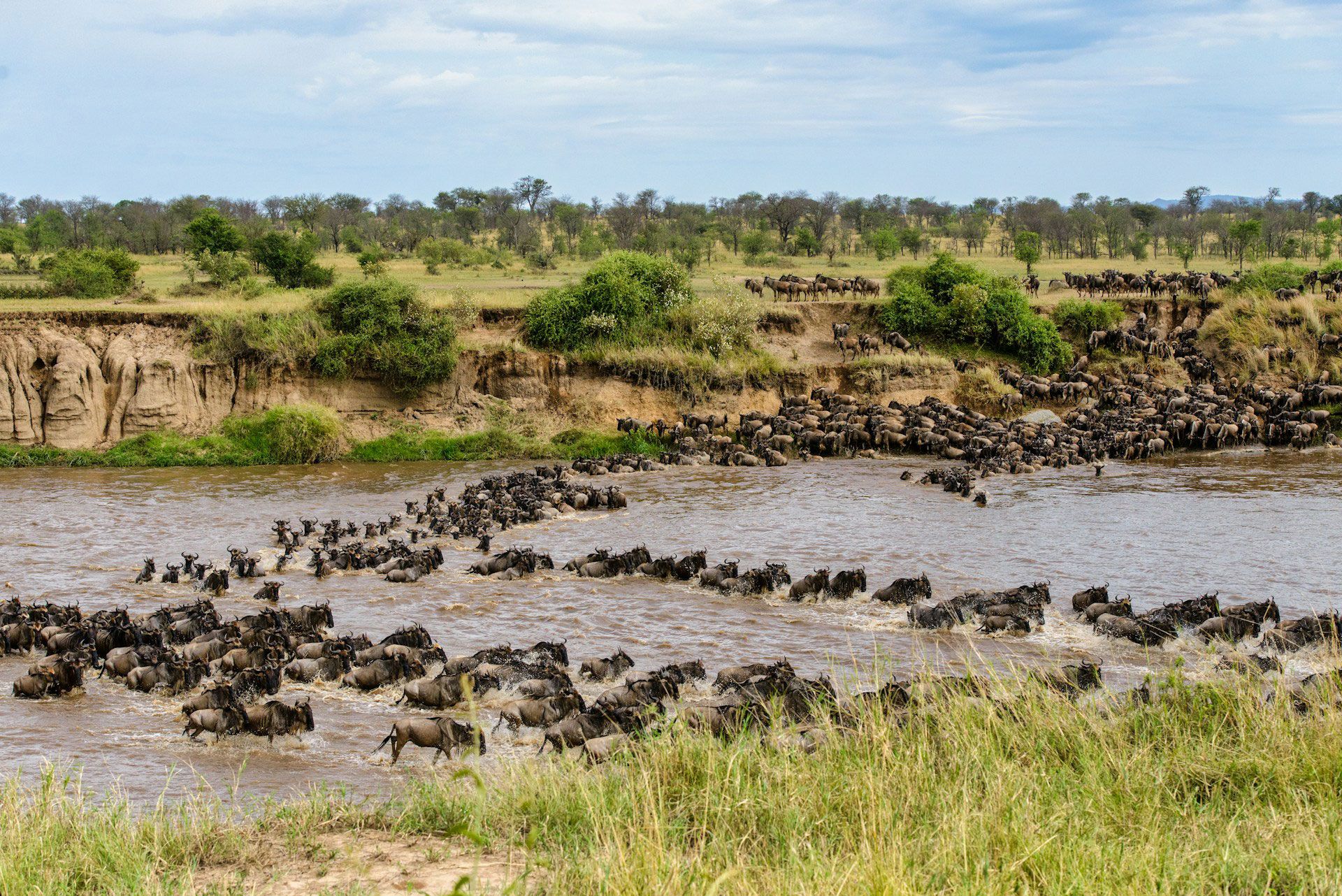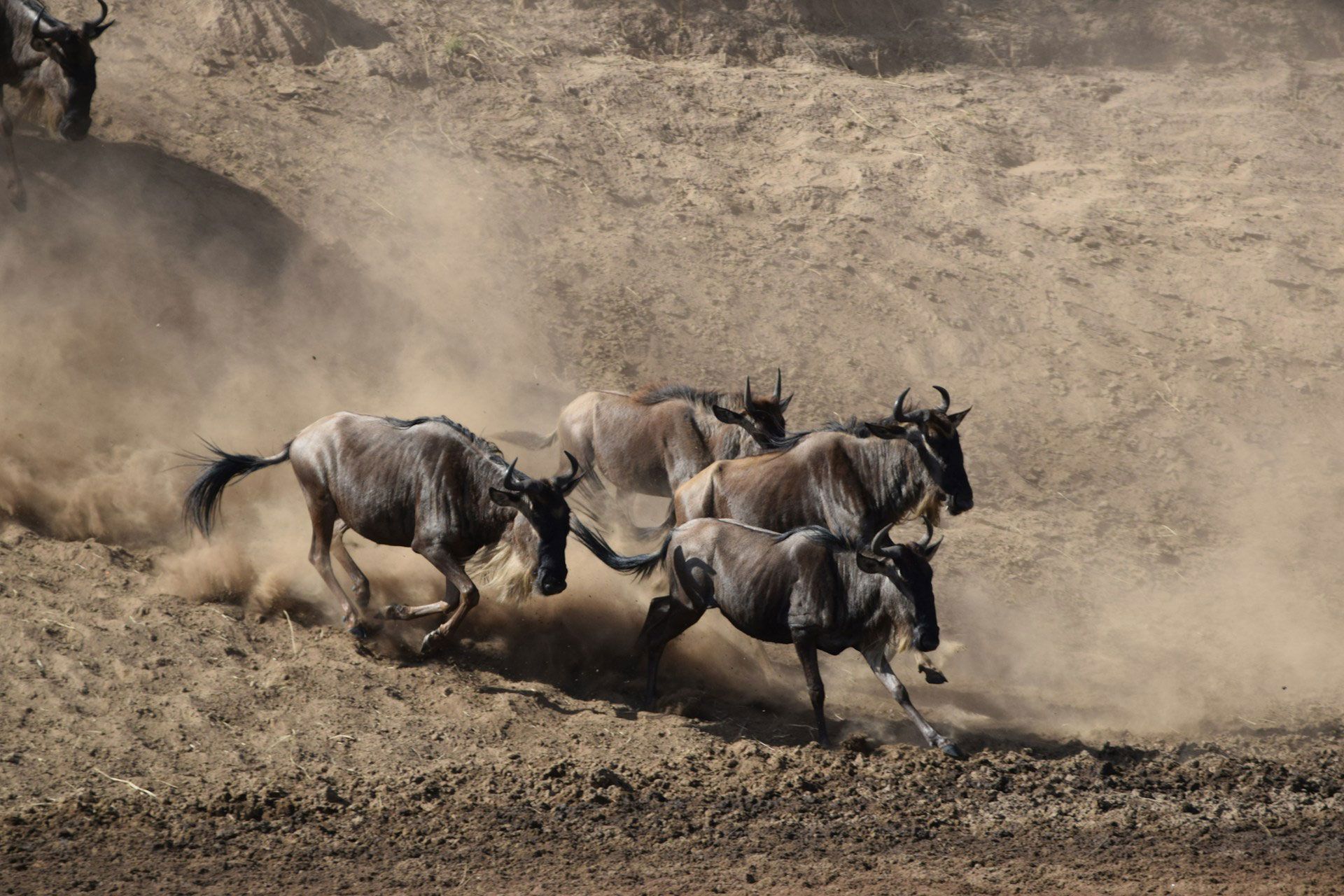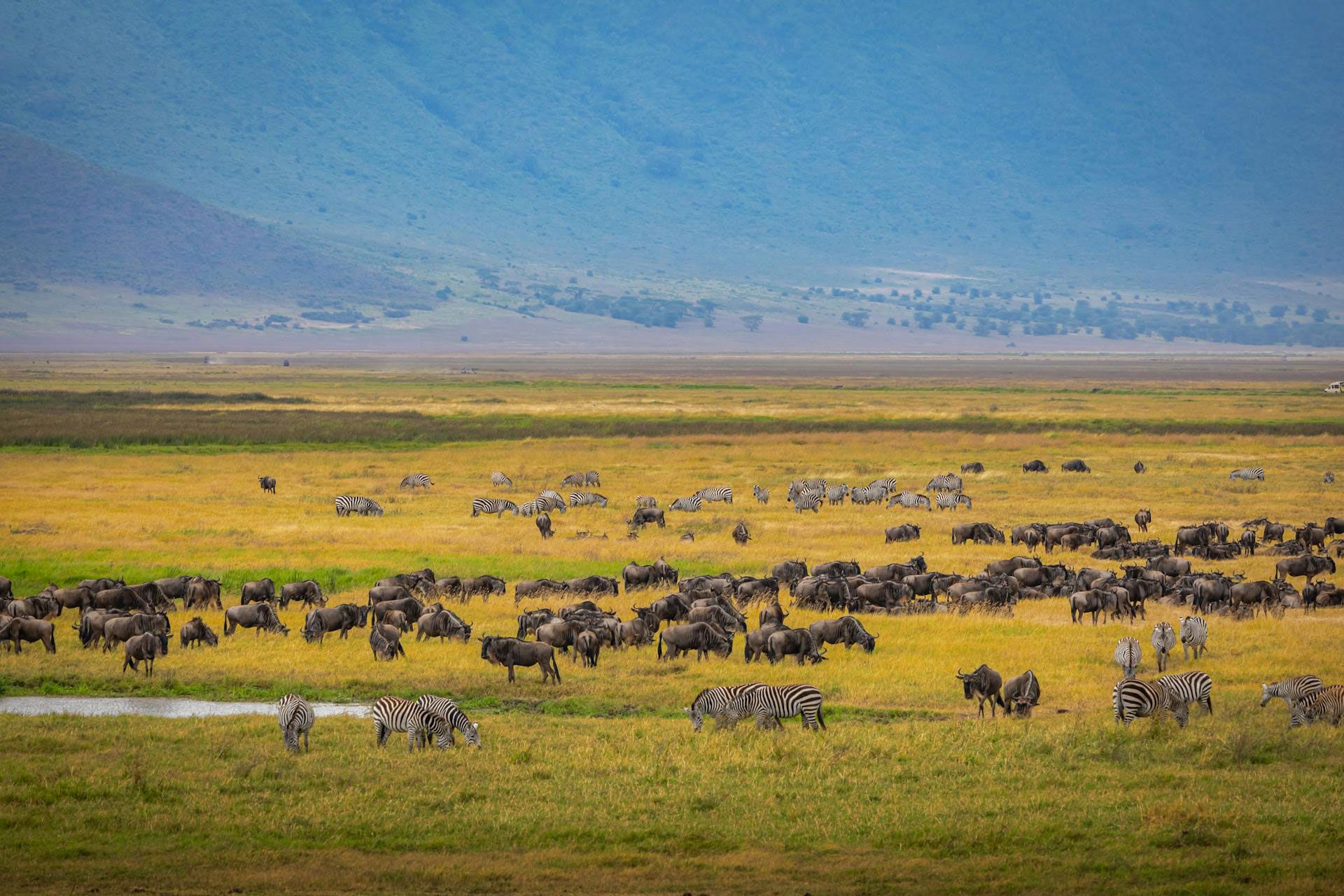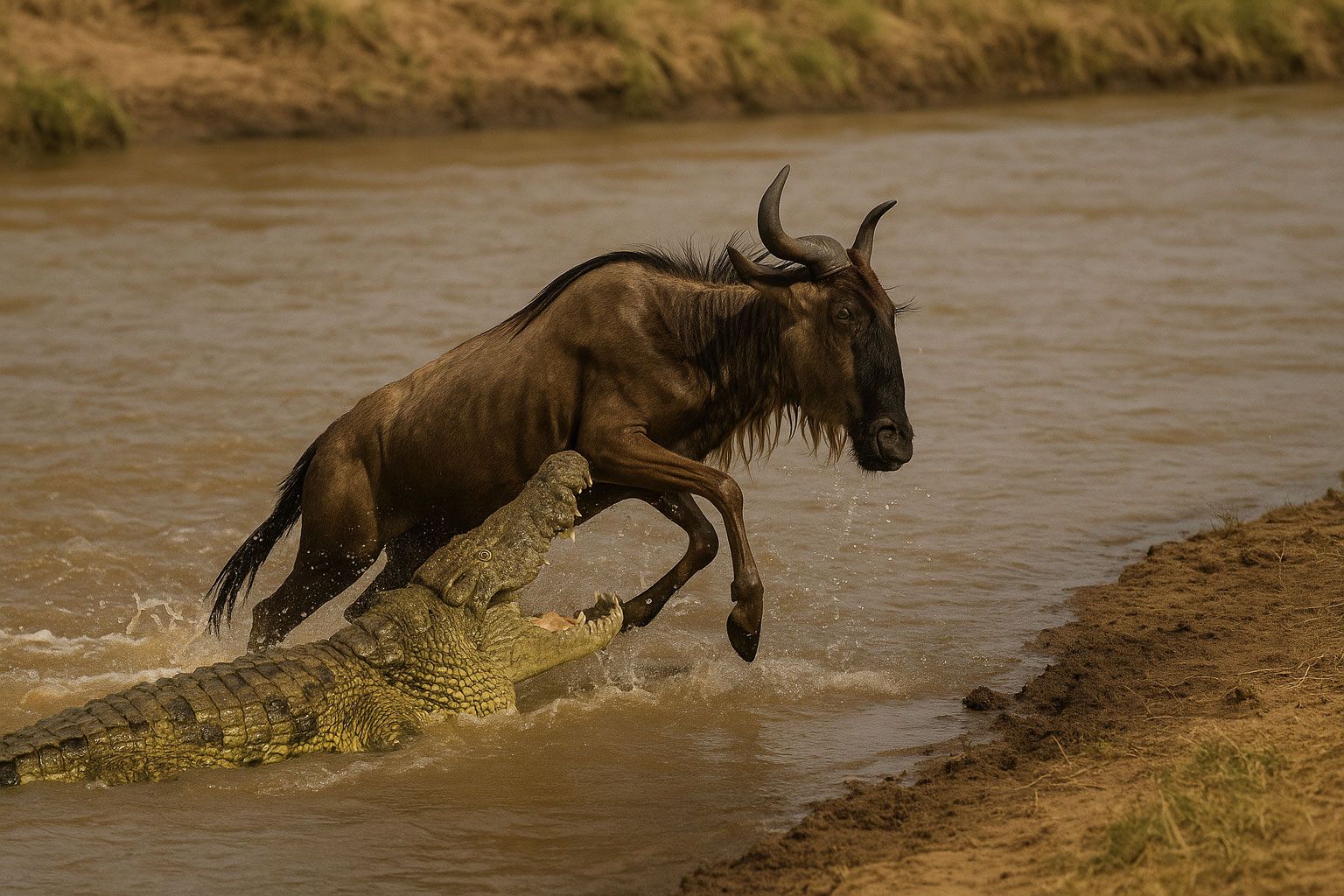
The Great Migration: A Photographer's Dream - Capturing Nature's Greatest Spectacle
6 min readImagine standing in the vastness of the East African savanna, camera in hand, as over 1.5 million wildebeest thunder across the plains in front of you. The Great Migration isn't just one of nature's most spectacular events—it's the ultimate photographer's canvas, offering endless opportunities to capture raw emotion, dramatic action, and breathtaking landscapes that will define your portfolio for years to come.
For adventure enthusiasts and photography lovers, the Great Migration represents the perfect fusion of adrenaline-pumping wildlife encounters and artistic excellence. Whether you're witnessing the dramatic Mara River crossings or the tender moments of newborn calves taking their first steps, every frame tells a story of survival, beauty, and the untamed spirit of Africa.
Photographing the Great Migration
- Understanding the Great Migration: Nature's Year-Round Drama
- The Migration Calendar: When to Capture What
- Essential Photography Gear for Migration Success
- Camera Bodies and Lenses
- Critical Accessories for Migration Photography
- Mastering Camera Settings for Migration Photography
- Understanding the Light: When Magic Happens
- Key Camera Settings for Different Scenarios
- Advanced Photography Techniques for Migration Drama
- Layering: Creating Depth in Your Migration Images
- Motion and Movement: Beyond the Static Shot
- Perspective Changes: Elevation for Impact
- Prime Locations for Migration Photography
- Tanzania: The Heart of the Migration
- Kenya: The Northern Drama
- Timing Your Photography Safari: Strategic Planning
- Peak Photography Seasons
- Ethical Photography: Respecting the Migration
- Wildlife Photography Ethics
- Key Ethical Guidelines
- Supporting Conservation Through Photography
- Planning Your Migration Photography Adventure
- Booking Considerations
- Weather and Climate Considerations
- Beyond the Migration: Additional Photography Opportunities
- The Supporting Cast
- Landscape Photography
- Frequently Asked Questions
- Key Takeaways for Migration Photography Success
Understanding the Great Migration: Nature's Year-Round Drama
The Great Migration is actually an ever-moving, circular migration with various but equally exciting events that occur year-round. This isn't just a seasonal spectacle—it's a continuous cycle of life, death, and renewal that offers photography opportunities throughout the entire year.

The Migration Calendar: When to Capture What
January to March: The Calving Season By February, the wildebeest herds reach the calving grounds in Ndutu, a lush area of the Serengeti where the herds give birth to over 500,000 calves. This period offers extraordinary photographic opportunities with abundant newborn animals and the predators that stalk them. The green, lush landscape created by the short rains makes for perfect photography opportunities, capturing the juxtaposition of life and death that defines the African wilderness.
April to June: The Northern Journey Starting this month, the wildebeest will continually be on the move, heading north through the Moru Kopjes and toward the Western Corridor. The impressive columns of wildebeest up to several kilometers long can be seen flooding the Moru Kopjes in the central area of the park during May, offering stunning wide-angle opportunities.
July to September: The Iconic River Crossings August is considered the peak of the migration season in the Masai Mara. The iconic Mara River crossings, where wildebeest risk their lives to cross crocodile-infested waters, happen during this time. This is when most photographers dream of being present—capturing the raw drama of survival against impossible odds.
October to December: The Return Journey As the year winds down, the herds of wildebeest begin their return journey south, offering opportunities for more tranquil photography with dramatic skies and vivid green landscapes.
Essential Photography Gear for Migration Success
Camera Bodies and Lenses
The Foundation: Camera Body Selection The first of my African safari photography tips is to invest in quality camera equipment. I would firmly recommend a full-frame camera. A full-frame camera provides a wider field of view and also tends to shoot better in low light, which is critical on a safari.
Lens Strategy: Coverage for Every Scenario I'd recommend combining that with a medium zoom, like a 70-200mm or a 100-400mm, and then a wide-angle lens, like a 24-70mm or a 16-35mm. This way, you can cover all the focal lengths with three lenses.
For serious migration photography, consider these focal length ranges:
- Wide-angle (16-35mm): Essential for capturing vast landscapes and environmental context
- Medium telephoto (70-200mm or 100-400mm): Perfect for animal portraits and closer action
- Super telephoto (150-600mm or longer): Critical for distant wildlife and detailed shots
For this reason, many safari photographers favor super-telephoto zooms in the region of 100-400mm or 150-600mm, which gives you plenty of range and flexibility.
Critical Accessories for Migration Photography
Support Systems You're in a photographic vehicle, and you need to rest your long or medium zoom lens on something. So, I recommend bringing a bean bag camera support. You can bring it empty, and get it filled with rice or beans at your safari camp, or at a hotel, so you don't have to carry the extra weight on the plane to Africa.
Essential Photography Kit
- At least two extra batteries per camera for full-day game drives
- Multiple high-capacity memory cards [verify current recommendations]
- Lens cleaning kit for dust protection
- Waterproof camera bag or cover for unexpected weather
- External hard drive for backup storage

Mastering Camera Settings for Migration Photography
Understanding the Light: When Magic Happens
Animals are most active around dawn and dusk, which is when the safari vehicles head out on game drives, so 'fast' lenses with wide maximum apertures are desirable. The golden hours around sunrise and sunset provide soft, warm, and directional light that not only enhances the natural colors of the environment but also creates long shadows, adding depth and dimension to your photographs.
Key Camera Settings for Different Scenarios
Shutter Speed Strategy Shutter speed is a very important part of choosing the best camera settings for safari photography. To capture crisp images with moving animals, you'll need a relatively quick shutter speed. Here are my suggestions:
- 1/100 for landscape if your camera is supported
- 1/400 for static animals
- 1/1250 – 1/2000 for fast moving animals
- 1/4000 for birds in flight or freezing water motion
Aperture Control for Impact Understanding aperture is one of the most important components of selecting the best camera settings for safari photography. Use wider apertures (f/2.8-f/5.6) to isolate subjects from backgrounds and create that professional wildlife photography look.
ISO Management ISO measures the sensitivity of the camera to light and essentially changes how bright your photo is. When there is less light (at dawn and dusk), increase your ISO settings for best results. However, note that if you dial up your ISO values too high, you'll start to get grainy photos.
Continuous Shooting Mode Wildlife moves a lot, so I shot a lot in burst mode/continuous shooting. On the positive side, I was able to capture so many cool shots. On the down side, I ended up with thousands of photos to sort through—despite the annoyance, I would highly recommend shooting in continuous mode to capture those epic shots.
Advanced Photography Techniques for Migration Drama
Layering: Creating Depth in Your Migration Images
The best technique I've found over the years is to pay attention to a concept called layering. With layering, you are deliberately looking for a scene with a strong foreground element, but also one that has fantastic depth to it as well. I'm specifically looking for a repetition of patterns that go deep into the scene.
Motion and Movement: Beyond the Static Shot
Harnessing the power of motion, and more specifically your camera's shutter speed, is a core tenet of great photography. The most usual way to harness shutter speed with moving animals is to "freeze" motion by ensuring you have a fast-enough shutter speed. But don't limit yourself—experiment with slower shutter speeds to create artistic motion blur that conveys the energy and movement of the migration.
Perspective Changes: Elevation for Impact
Simply put, by changing your perspective, you are able to get a greater angle with which to photograph the sizable herds that may just not otherwise be photogenic from the ground. Notice how just that slight elevation creates for an altogether different sense of depth and scale to the great migration.
Prime Locations for Migration Photography
Tanzania: The Heart of the Migration
Serengeti National Park The Serengeti is definitely one of the best places to witness the Great Migration, as large herds of Wildebeest and Zebra begin to congregate. The Grumeti River makes for an imposing barrier which the animals need to gather up the courage to cross.
Ngorongoro Conservation Area Located in Tanzania's north, the Ngorongoro Conservation Area is the place to see newborn Wildebeest and Zebras during calving season. The abundance of young prey also means you might have a greater chance of experiencing Lion, Leopard, and other predator attacks during your visit.
Kenya: The Northern Drama
Masai Mara National Reserve The animals that make it to these feeding grounds can now fatten up before returning to the Ngorongoro to give birth again. But they also face one of East Africa's greatest densities of lions. The Maasai Mara also offers excellent sightings of Elephants and Giraffes, as well as rarer species such as the Topi.
Timing Your Photography Safari: Strategic Planning
Peak Photography Seasons
River Crossing Season (July-September) The dramatic Mara River crossings with intense predator-prey action offer high concentrations of wildlife for optimal game drives. This period is a photographer's dream, with action-packed scenes and a variety of opportunities to capture the raw beauty of Africa's wildlife.
Calving Season (January-March) Witnessing the birth of new life amidst the vast African savannah is an extraordinary experience that captures the essence of the circle of life. February, in particular, stands out as a remarkable month, as it marks the peak of the calving season.
Quieter Seasons (November-December, April-May) These periods offer quieter, more tranquil safari experiences with fewer tourists. The rains bring a unique beauty to the environment, with dramatic skies and vivid green landscapes that make for stunning photography.

Ethical Photography: Respecting the Migration
Wildlife Photography Ethics
Ethical safaris follow proper safari etiquette: they encourage tourists to keep their distance, avoid contact and flash photography, and speak quietly so as to not disturb the wildlife. They also limit the time spent inside the reserve, as their main focus is to reduce stress on the animals.
Key Ethical Guidelines
- Maintain Distance: Let animals go about their business without seeking their attention or interaction
- No Flash Photography: Flash can disturb wildlife, especially during sensitive periods like feeding or breeding
- Respect Breeding Seasons: Take special care during calving season and other sensitive times
- Follow the Signs: Know the signs of stress in your subject species and back away immediately
- Leave No Trace: Do not destroy or alter habitat for a better view or scene
Supporting Conservation Through Photography
Ethical tourism is a powerful catalyst for community development, providing local populations with economic opportunities that are tied to the preservation of their natural resources. Choose operators that demonstrate clear conservation commitments and community involvement.
Planning Your Migration Photography Adventure
Booking Considerations
Advance Planning is Essential Book as soon as you know you want to go – don't procrastinate! Lodges and camps are small and fill up very quickly. The river-crossing season is the most popular, so start planning at least a year in advance.
Mobile vs. Permanent Camps Accommodation for a Great Migration safari can be divided into two broad categories: permanent lodges and mobile camps. Mobile camps can relocate to follow the herds, offering closer proximity to the action.
Weather and Climate Considerations
Remember that climate change means the long and short rainy seasons in Tanzania and Kenya are no longer as regular or predictable as they once were. The rains can be late or early, which will throw the whole wildebeest calendar out of sync. This is why it's important to plan for as much time on safari as possible.
Although many people think of Africa as a hot place, the rain can cool things down dramatically. You'll be out on early morning and late afternoon game drives – the sun is at its weakest during these times. Take at least one pair of trousers, closed shoes that can cope with mud, and a fleece or waterproof jacket.
Beyond the Migration: Additional Photography Opportunities
The Supporting Cast
While the wildebeest are the stars, don't forget the supporting cast. The migration includes zebras, Thomson's gazelles, and other antelope species, plus all the predators that follow them—lions, leopards, cheetahs, hyenas, and crocodiles. Each species offers unique photographic opportunities and behaviors to capture.
Landscape Photography
The East African landscape itself is a photographer's dream. From the endless Serengeti plains to the dramatic escarpments of the Rift Valley, wide-angle opportunities abound. The interplay of light and landscape, especially during golden hour, can create images that are every bit as powerful as your wildlife shots.
Frequently Asked Questions
Key Takeaways for Migration Photography Success
Key Takeaways for Migration Photography Success
- Plan for flexibility: Weather and animal movements can change plans quickly
- Invest in quality telephoto capability: The migration demands serious reach
- Master your camera settings before you go: Practice with your gear extensively
- Bring backup equipment: Batteries, memory cards, and even backup cameras if possible
- Respect the wildlife: Ethical photography ensures these experiences remain available for future generations
- Book with reputable operators: Choose safari companies that demonstrate clear conservation commitments
- Consider mobile camps: They can position you closer to the migration route
The Great Migration offers photographers a chance to witness and document one of nature's most incredible spectacles. With proper preparation, ethical practices, and the right equipment, you'll return home with not just stunning images, but memories and stories that will last a lifetime.
Ready to turn your photography dreams into reality? Start planning your Great Migration photography safari with Tsavaro and let our local expertise guide you to the perfect shots while supporting conservation and local communities.
Disclaimer: Always verify current visa requirements with official sources. Prices and availability subject to change - check current rates on Tsavaro. Weather patterns are general - check current conditions before travel.